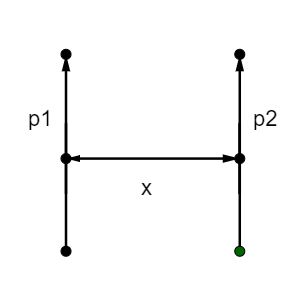
The force of interaction of two dipoles, if the two dipoles are parallel to each other and placed at distance x apart.

1. \[\dfrac{{3{p_1}{p_2}}}{{4\pi {\varepsilon _ \circ }{x^4}}}\]
2. \[\dfrac{{{p_1}{p_2}}}{{4\pi {\varepsilon _ \circ }{x^4}}}\]
3. \[\dfrac{{{p_1}{p_2}}}{{4\pi {\varepsilon _ \circ }{x^4}}}\]
4. \[\dfrac{{{p_1}{p_2}}}{{3\pi {\varepsilon _ \circ }{x^4}}}\]
Answer
218.4k+ views
Hint: First, we will need to find the electrostatic field of dipole \[{p_2}\] at \[{p_1}\] . Then we will find the potential energy of two dipoles. In the final step we will differentiate the potential energy to get the Force of interaction between two dipoles.
Complete step-by-step Solution
A dipole is separation of two opposite charges and it is quantified by electric dipole moment and is denoted by p.
As we know electric field of dipole along perpendicular bisector of the axis,
\[\overrightarrow E = - \dfrac{{\overrightarrow p }}{{4\pi {\varepsilon _ \circ }{r^3}}}\] , where r= distance
\[{\varepsilon _ \circ }\] = permittivity of free space
\[{E_{21}}\] is the field due to dipole \[{p_1}\] at dipole \[{p_2}\]
\[{E_{21}} = \dfrac{{{p_1}}}{{4\pi {\varepsilon _ \circ }{x^3}}}\]
Potential energy of dipole system
\[U = - \overrightarrow {{p_2}} .\overrightarrow {{E_{21}}} \]
\[U = - {p_2}\dfrac{{{p_1}}}{{4\pi {\varepsilon _ \circ }{x^3}}}\cos (\pi )\]
Angle between the dipole and electric field is 180 degrees.
\[U = \dfrac{{{p_1}{p_2}}}{{4\pi {\varepsilon _ \circ }{x^3}}}\]
Now, to find the force
\[F = - \dfrac{{dU}}{{dx}} = \dfrac{3}{{4\pi {\varepsilon _ \circ }}}\dfrac{{{p_1}{p_2}}}{{{x^4}}}\]
F is positive, so it is a repulsive force.
Option (1) \[\dfrac{{3{p_1}{p_2}}}{{4\pi {\varepsilon _ \circ }{x^4}}}\]
Additional Information
Electric field due to dipole at a general point
\[E = \dfrac{1}{{4\pi {\varepsilon _ \circ }}}\dfrac{p}{{{r^3}}}\sqrt {3{{\cos }^2}\theta + 1} \] , \[\theta \] =angle between the distance vector and dipole.
Potential due to dipole at a general point
\[V = \dfrac{{p\cos \theta }}{{4\pi {\varepsilon _ \circ }{r^2}}}\]
Note
1. You need to keep in mind the direction of the electric field and dipole.
2. While using the formula of potential energy of dipole, you need to find the angle between field and dipole otherwise you will get the wrong force direction.
3. While finding electric fields, Approximation is made that the length of the dipole is negligible as compared to the distance of the point from the dipole.
Complete step-by-step Solution
A dipole is separation of two opposite charges and it is quantified by electric dipole moment and is denoted by p.
As we know electric field of dipole along perpendicular bisector of the axis,
\[\overrightarrow E = - \dfrac{{\overrightarrow p }}{{4\pi {\varepsilon _ \circ }{r^3}}}\] , where r= distance
\[{\varepsilon _ \circ }\] = permittivity of free space
\[{E_{21}}\] is the field due to dipole \[{p_1}\] at dipole \[{p_2}\]
\[{E_{21}} = \dfrac{{{p_1}}}{{4\pi {\varepsilon _ \circ }{x^3}}}\]
Potential energy of dipole system
\[U = - \overrightarrow {{p_2}} .\overrightarrow {{E_{21}}} \]
\[U = - {p_2}\dfrac{{{p_1}}}{{4\pi {\varepsilon _ \circ }{x^3}}}\cos (\pi )\]
Angle between the dipole and electric field is 180 degrees.
\[U = \dfrac{{{p_1}{p_2}}}{{4\pi {\varepsilon _ \circ }{x^3}}}\]
Now, to find the force
\[F = - \dfrac{{dU}}{{dx}} = \dfrac{3}{{4\pi {\varepsilon _ \circ }}}\dfrac{{{p_1}{p_2}}}{{{x^4}}}\]
F is positive, so it is a repulsive force.
Option (1) \[\dfrac{{3{p_1}{p_2}}}{{4\pi {\varepsilon _ \circ }{x^4}}}\]
Additional Information
Electric field due to dipole at a general point
\[E = \dfrac{1}{{4\pi {\varepsilon _ \circ }}}\dfrac{p}{{{r^3}}}\sqrt {3{{\cos }^2}\theta + 1} \] , \[\theta \] =angle between the distance vector and dipole.
Potential due to dipole at a general point
\[V = \dfrac{{p\cos \theta }}{{4\pi {\varepsilon _ \circ }{r^2}}}\]
Note
1. You need to keep in mind the direction of the electric field and dipole.
2. While using the formula of potential energy of dipole, you need to find the angle between field and dipole otherwise you will get the wrong force direction.
3. While finding electric fields, Approximation is made that the length of the dipole is negligible as compared to the distance of the point from the dipole.
Recently Updated Pages
Arithmetic, Geometric & Harmonic Progressions Explained

Cartesian Form of Vector Explained: Formula, Examples & Uses

Apparent Frequency Explained: Formula, Uses & Examples

Calorimetry: Definition, Principles & Calculations

Centrifugal Force Explained: Definition, Formula & Examples

Charge in a Magnetic Field: Definition, Formula & Examples

Trending doubts
JEE Main 2026: Application Form Open, Exam Dates, Syllabus, Eligibility & Question Papers

Derivation of Equation of Trajectory Explained for Students

Hybridisation in Chemistry – Concept, Types & Applications

Understanding the Angle of Deviation in a Prism

Understanding Collisions: Types and Examples for Students

Understanding Atomic Structure for Beginners

Other Pages
JEE Advanced Marks vs Ranks 2025: Understanding Category-wise Qualifying Marks and Previous Year Cut-offs

How to Convert a Galvanometer into an Ammeter or Voltmeter

Ideal and Non-Ideal Solutions Explained for Class 12 Chemistry

Degree of Dissociation: Meaning, Formula, Calculation & Uses

Understanding Electromagnetic Waves and Their Importance

Understanding Average and RMS Value in Electrical Circuits




